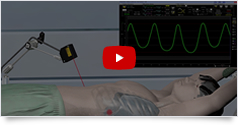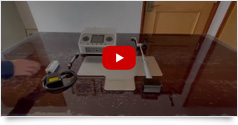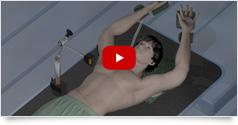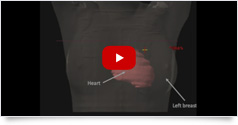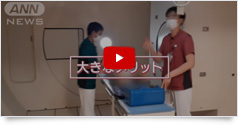Support
Movie
How to calibrate load cell sensor
How to calibrate (AZ-733V)(STANDARD)
How to calibrate (AZ-733VI)(DEEP)
User Report

Dr. Takashi Ogino Director, International Proton Therapy Center
Connection Device: Proton therapy device (Mitsubishi Electric)
Purpose of use: Respiratory gated irradiation of lung and liver tumors
Dr. Ogino has been witnessed the establishment of the National Cancer Center East Hospital, which was the first proton therapy facility dedicated to medical treatment in Japan in 1996, and has been involved with Anzai Medical’s respiratory gating system for more than 10 years.
Respiratory gated irradiation is indispensable for the treatment that obtains the effect of radiation focused on cancer lesions while reducing the effect on normal tissues, which is a characteristic of proton beam therapy. We would like to introduce the comments from Dr. Ogino who has lots of clinical experience.
“In the early days of Anzai Medical’s respiratory gating system, handling the respiratory sensor was sometimes difficult, but with the current laser sensor, it is easy to administer to the patient, and the obtained respiratory waveform also correlates with the target. I am convinced that respiratory-gated irradiation is generally said to be longer and more inefficient than regular irradiation, but it does not take much time in cooperation with the patient. Rather than pointing out that the efficiency of the treatment time is reduced by performing respiratory-gated irradiation, the side effect of irradiating the human body with radiation (normal tissue) It seems that there is a relative risk in the treatment that does not make use of the characteristics of the proton beam, which can suppress the inflammation of cancer and the cancer that arises from low exposure).
It is very strange for me that there are few examples of Respiratory sync irradiation”.
References
The first paper showing the advantage of visual feedback for left breast DIBH(2024)
Novel breath-hold liver target stereotactic ablative radiotherapy using the intrafraction diaphragm registration of kiV projection streaming image with DRR of the planning CT
Published by:Technical Innovations & Patient Support in Radiation Oncology 27 (2023)
Data-Driven Respiratory Gating Outperforms Device-Based Gating.
Published by: the Society of Nuclear Medicine and Molecular Imaging(2020)
Mizuno, Hideyuki, et al. “Commissioning of a respiratory gating system involving a pressure sensor in carbon‐ion scanning radiotherapy.”
Published by: Journal of Applied Clinical Medical Physics, 20.1 (2019): 37-42.
Feasibility of Systematic Respiratory-Gated Acquisition
Published by: Feasibility of Systematic Respiratory-Gated Acquisition (2018)
Cummings, David, et al. “Four-dimensional Plan Optimization for the Treatment of Lung Tumors Using Pencil-beam Scanning Proton Radiotherapy.”
Published by: Cureus Journal of Medical Science, 10.8 (2018)
Combined Electrocardiography- and RespiratoryTriggered CT of the Lung to Reduce Respiratory
Published by: Korean J Radiol (2017)
Snyder, Jeffrey E., Ryan T. Flynn, and Daniel E. Hyer. “Implementation of respiratory‐gated VMAT on a Versa HD linear accelerator.”
Published by: Journal of Applied Clinical Medical Physics, 18.5 (2017): 152-161.
Büther, Florian, et al. “Impact of data-driven respiratory gating in clinical PET.”
Published by: Radiology, 281.1 (2016): 229-238.
Delivery_efficiency_of_an_Elekta_linac_under_gated
Published by: JOURNAL OF APPLIED CLINICAL MEDICAL PHYSICS(2014)
Grootjans, Willem, et al. “Amplitude-based optimal respiratory gating in positron emission tomography in patients with primary lung cancer.”
Published by: European Radiology, 24.12 (2014): 3242-3250.
Martinez-Möller, Axel, et al. “Dual cardiac–respiratory gated PET: implementation and results from a feasibility study.”
Published by: European Journal of Nuclear Medicine and Molecular Imaging, 34.9 (2007): 1447-1454.
The Management of Respiratory Motion in Radiation Oncology – Report of AAPM Task Group 76.
Published by: American Association of Physicists in Medicine (2006).
Q&A
- Which delivers greater accuracy, load cells or laser sensors?
- There is no difference in sensitivity between the two, so please use that which suits your purposes. Load cells, which are affixed directly to a patient’s body, are suitable for use with PET-CT machines with a deep gantry. Non-contact laser sensors, which are not directly affixed to a patient, are suitable for use in radiation therapy and with fixed equipment.
- What is the difference between “standard” and “deep” load cells?
- Standard load cells offer higher sensitivity, while deep load cells provide a greater range of measurement. Furthermore, standard load cells are used for patients with relatively small respiratory motions. Deep load cells are used for patients with larger respiratory motions.
- There is no test waveform output.
- “TEST SIGNAL” must be enabled in the software settings. All components (sensors, etc.) must also be connected. If “Test Signal” is displayed in the center of the application screen but the test waveform is not displayed, adjust the Magnification/Position.
- How can I connect multiple external devices to the AZ-733VI system?
- You will need to add a dedicated cable and interface for each connected device. Connection cables may be added as needed.
- What type of cables should be used?
- Please refer to the connection guide below.

- How frequently should maintenance be performed?
- Annual low-voltage power supply, detector performance, and comprehensive operation testing (fee-based) is recommended.
- How long is the warranty period?
- The warranty is valid for one and a half years after delivery, but a 1 to 5 year extended warranty service is available for a fee.
How to calibrate load cell sensor
How to calibrate (AZ-733V)(STANDARD)
How to calibrate (AZ-733VI)(DEEP)
User Report

Dr. Takashi Ogino Director, International Proton Therapy Center Connection Device: Proton therapy device (Mitsubishi Electric) Purpose of use: Respiratory gated irradiation of lung and liver tumors
Dr. Ogino has been witnessed the establishment of the National Cancer Center East Hospital, which was the first proton therapy facility dedicated to medical treatment in Japan in 1996, and has been involved with Anzai Medical’s respiratory gating system for more than 10 years. Respiratory gated irradiation is indispensable for the treatment that obtains the effect of radiation focused on cancer lesions while reducing the effect on normal tissues, which is a characteristic of proton beam therapy. We would like to introduce the comments from Dr. Ogino who has lots of clinical experience. “In the early days of Anzai Medical’s respiratory gating system, handling the respiratory sensor was sometimes difficult, but with the current laser sensor, it is easy to administer to the patient, and the obtained respiratory waveform also correlates with the target. I am convinced that respiratory-gated irradiation is generally said to be longer and more inefficient than regular irradiation, but it does not take much time in cooperation with the patient. Rather than pointing out that the efficiency of the treatment time is reduced by performing respiratory-gated irradiation, the side effect of irradiating the human body with radiation (normal tissue) It seems that there is a relative risk in the treatment that does not make use of the characteristics of the proton beam, which can suppress the inflammation of cancer and the cancer that arises from low exposure).It is very strange for me that there are few examples of Respiratory sync irradiation”.
References
The first paper showing the advantage of visual feedback for left breast DIBH(2024) Novel breath-hold liver target stereotactic ablative radiotherapy using the intrafraction diaphragm registration of kiV projection streaming image with DRR of the planning CT Published by:Technical Innovations & Patient Support in Radiation Oncology 27 (2023) Data-Driven Respiratory Gating Outperforms Device-Based Gating. Published by: the Society of Nuclear Medicine and Molecular Imaging(2020) Mizuno, Hideyuki, et al. “Commissioning of a respiratory gating system involving a pressure sensor in carbon‐ion scanning radiotherapy.” Published by: Journal of Applied Clinical Medical Physics, 20.1 (2019): 37-42. Feasibility of Systematic Respiratory-Gated Acquisition Published by: Feasibility of Systematic Respiratory-Gated Acquisition (2018) Cummings, David, et al. “Four-dimensional Plan Optimization for the Treatment of Lung Tumors Using Pencil-beam Scanning Proton Radiotherapy.” Published by: Cureus Journal of Medical Science, 10.8 (2018) Combined Electrocardiography- and RespiratoryTriggered CT of the Lung to Reduce Respiratory Published by: Korean J Radiol (2017) Snyder, Jeffrey E., Ryan T. Flynn, and Daniel E. Hyer. “Implementation of respiratory‐gated VMAT on a Versa HD linear accelerator.” Published by: Journal of Applied Clinical Medical Physics, 18.5 (2017): 152-161. Büther, Florian, et al. “Impact of data-driven respiratory gating in clinical PET.” Published by: Radiology, 281.1 (2016): 229-238. Delivery_efficiency_of_an_Elekta_linac_under_gated Published by: JOURNAL OF APPLIED CLINICAL MEDICAL PHYSICS(2014) Grootjans, Willem, et al. “Amplitude-based optimal respiratory gating in positron emission tomography in patients with primary lung cancer.” Published by: European Radiology, 24.12 (2014): 3242-3250. Martinez-Möller, Axel, et al. “Dual cardiac–respiratory gated PET: implementation and results from a feasibility study.” Published by: European Journal of Nuclear Medicine and Molecular Imaging, 34.9 (2007): 1447-1454. The Management of Respiratory Motion in Radiation Oncology – Report of AAPM Task Group 76. Published by: American Association of Physicists in Medicine (2006).Q&A
- Which delivers greater accuracy, load cells or laser sensors?
- There is no difference in sensitivity between the two, so please use that which suits your purposes. Load cells, which are affixed directly to a patient’s body, are suitable for use with PET-CT machines with a deep gantry. Non-contact laser sensors, which are not directly affixed to a patient, are suitable for use in radiation therapy and with fixed equipment.
- What is the difference between “standard” and “deep” load cells?
- Standard load cells offer higher sensitivity, while deep load cells provide a greater range of measurement. Furthermore, standard load cells are used for patients with relatively small respiratory motions. Deep load cells are used for patients with larger respiratory motions.
- There is no test waveform output.
- “TEST SIGNAL” must be enabled in the software settings. All components (sensors, etc.) must also be connected. If “Test Signal” is displayed in the center of the application screen but the test waveform is not displayed, adjust the Magnification/Position.
- How can I connect multiple external devices to the AZ-733VI system?
- You will need to add a dedicated cable and interface for each connected device. Connection cables may be added as needed.
- What type of cables should be used?
- Please refer to the connection guide below.

- How frequently should maintenance be performed?
- Annual low-voltage power supply, detector performance, and comprehensive operation testing (fee-based) is recommended.
- How long is the warranty period?
- The warranty is valid for one and a half years after delivery, but a 1 to 5 year extended warranty service is available for a fee.


